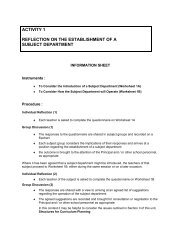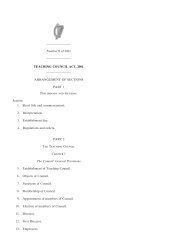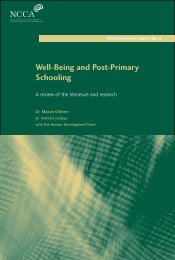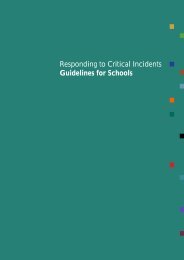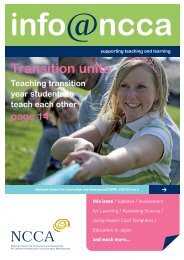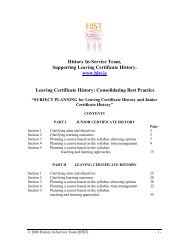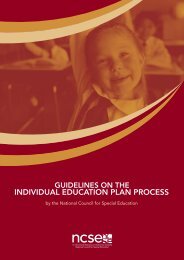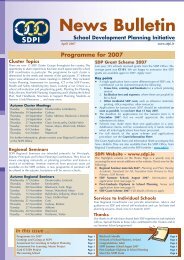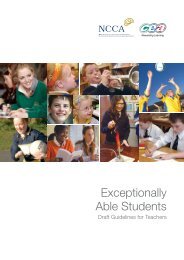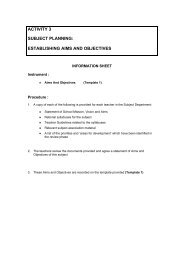Co-Operative School Evaluation Project (File Format PDF 550KB)
Co-Operative School Evaluation Project (File Format PDF 550KB)
Co-Operative School Evaluation Project (File Format PDF 550KB)
Create successful ePaper yourself
Turn your PDF publications into a flip-book with our unique Google optimized e-Paper software.
COOPERATIVE SCHOOL EVALUATION PROJECT<br />
EVALUATION OF INDICATORS AND INSTRUMENTS<br />
The judgements formed using these indicators need to take into account the context of the school in terms of these<br />
external resources. They also need to take into account the internal difficulties faced by schools. For instance, the<br />
design phase can be easy to organise, as teams contribute their current expertise to developing a template for a policy<br />
or activity. However, turnover in staff and students has a major effect on the implementation and impact phases of<br />
planning. Individuals change roles and at times their expertise is lost to the school. New people may not have been<br />
involved in the design, or may not share the same perspective as the previous person in the role. This makes for<br />
difficulty in having continuity in implementation. <strong>Evaluation</strong>s that show deficits in these areas of planning may well<br />
point to a need for system support, rather than reflect badly on schools.<br />
5.3 Instrumentation<br />
The instrumentation involved two main techniques - document review and interview.<br />
Document review gave valuable insights into the history of the planning process. The analysis template in<br />
Instrument A was rated as very helpful. In some cases, however, the process was found to be a time-consuming and<br />
complex activity. A policy might be described over a range of different documents. Difficulties also arose when<br />
schools did not retain documentary evidence of a planning process beyond a certain number of years. In general,<br />
documentary evidence tended to deal with the product of planning rather than the process. This difficulty should<br />
not necessarily be interpreted negatively in the evaluation of a school’s approach to the process of planning.<br />
The instrumentation sought triangulation of evidence from a number of different sources. The value of planning for<br />
triangulation of data was strongly supported by the evaluators. In most of the trials there was a strong element of<br />
congruence in the data. However, the focus on different partners was important in highlighting different<br />
perspectives on the planning process.<br />
The instrumentation was designed as a comprehensive set of tools to verify the validity and reliability of the<br />
indicators. The evaluators were satisfied that the instruments achieved their purpose.<br />
• The instruments identified evidence of the existence of the planning process, e.g. if there were written procedures<br />
familiar to stakeholders in school or to what extent students and parents were involved.<br />
• In the opinion of the interviewees the questions pointed at crucial issues in the planning process of the chosen<br />
policy by identifying existing good practice as well as areas for further development<br />
When used in practice, the same comprehensiveness of approach may not be needed. Once the indicators have been<br />
confirmed, then different approaches can be used to verify that the indicator has been implemented and the extent<br />
to which it has achieved its purpose. The comprehensiveness used will depend on the use being made of the<br />
evaluation. As in all evaluations, there needs to be a sensitive balance between challenge and support in using an<br />
external template against which any policy process is evaluated.<br />
The interview approach gave rise to good quality information and enhanced the dialogue with partners. It was found<br />
that the interview instruments B, C, D, and E, provided useful guidelines for evaluators. The instruments, as<br />
published, were intended as templates for evaluations rather than for use in a prescriptive way. For instance, when<br />
dealing with younger students in a primary school, interview questions had to be adapted. Individual and focusgroup<br />
interviews are intense and involve a limited number of participants. They provide rich data. They are highly<br />
effective in uncovering the internal dynamics of the planning process. Some evaluators queried whether a balance<br />
between questionnaire and interview techniques might increase the participation of some partners without losing<br />
out on the quality of the information. Questionnaire instruments could be developed to suit different purposes and<br />
contexts.<br />
38<br />
39



